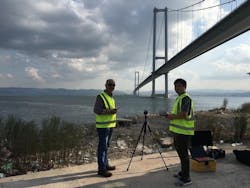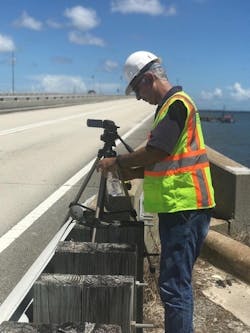Technological innovation will protect and advance our nation’s infrastructure
It’s no secret that the infrastructure supporting our nation’s transportation system is in disrepair, if not outright crisis. According to the Infrastructure Report Card, of the more than four million miles of public roadways in the U.S., over 40% is in poor or mediocre condition.
Government leaders and media pundits speak of the need for massive investment to address this challenge, but it is not just about equipment, materials, and workers. We must also invest in technological innovation to advance infrastructure improvements that will drive our economy.
As pressure mounts to meet current and projected economic demands—not just moving goods and people but also connecting low-income and underserved communities with unrestricted access to equitable, high-paying jobs—researchers have been tasked with developing new and innovative technology-based methods of monitoring infrastructure health.
One key area where research is beginning to have a significant impact is in nondestructive testing and structural health monitoring, which have long been integral to objective assessment and maintenance of roads and bridges, but come at a high cost to commuters. According to the American Society of Civil Engineers (ASCE), motorists pay more than $1,000 every year in wasted time and fuel due to the impacts testing (and associated road closures) have on their daily commutes.
Presently, the structural health monitoring method typically involves monitoring a structure over a certain time period, using an array of sensors and devices, then extracting and analyzing the data to determine the current state of the structure.
Similarly, nondestructive testing is a suite of sensing, imaging, and analysis techniques that assess the quality of materials, components, and structures. Both structural health monitoring and nondestructive testing aim to assess the integrity of a structure in a nondestructive manner, but the current manual and ultrasonic systems require lane closures that could last between six and eight hours, while also posing serious safety hazards to drivers and those in the work zone.
Improving the way roads, bridges, and other infrastructure are monitored could improve safety, lower costs, and play a role in meeting the needs of “smart cities” of the future. The good news is that government-funded research is already having an impact even as Congressional funding is being debated.
As an example, Transtek International Group (TIG), a technology spin-off at the University of Central Florida’s Business Incubation Program, has been working to translate its research on nondestructive testing and structural health monitoring into a product that could alter the way we monitor roads, bridges, and other infrastructure in the future.
Recognizing that innovation benefits from collaboration, the team worked with partners at the Florida High Tech Corridor to form a cross-regional partnership with Dr. Rasim Guldiken at the University of South Florida to push this forward. Dr. Guldiken and his team have unique expertise in ultrasonic sensing development that is critical for the project.
Connecting universities and corporate partners across regional boundaries is one of the reasons The Corridor was formed. As an economic development initiative of the University of Central Florida, University of South Florida, and University of Florida, The Corridor and its signature Matching Grants Research Program (MGRP) provide not only direct funding but also support for funding through other sources, in this case a grant from the U.S. Department of Transportation. The MGRP program also brought connections to student researchers at USF to assist with the project as they work toward their doctoral and master’s degrees.
The result—a patent-pending Fast Track Ultrasonic Imaging Technology—can determine key evaluation markers such as load carrying capacity, load rating, and concrete surface inspections simply by driving a specialized vehicle across a road or bridge allowing engineers to determine potential issues within a structure in a matter of minutes, rather than hours. Additionally, using fast-acting ultrasonic imaging, engineers can measure factors unseen to the naked eye, such as the durability of the concrete. The vision is to someday see this technology embedded in every car on the road.
Similar advancements in infrastructure technology could be key to America solving its long-time issues of developing and maintaining infrastructure health in order to drive economic growth. Think of how common high-tech sensors are now in automotive manufacturing and imagine if we could harness that computing power to quickly and safely monitor the health of our infrastructure.
The impact of innovation could be enormous, not only here in the U.S. but also around the world. In recent years, bridge collapses have claimed lives in Mexico, France, China, and India, among others, increasing the demand for smarter and more reliable infrastructure. Faulty infrastructure has cost millions of dollars in aftermath recovery efforts. As a result, many cities are using different types of electronic methods and sensors to collect specific data along with specialized models (Digital Twins) in order to develop, deploy, and promote sustainable development practices and improve operations across the city. More cities adopting this framework will result in a reduction of the cost of operation and maintenance of roads and bridges while also increasing structural safety that is also sustainable for years to come.
Sensors can be embedded into bridges, buildings, and public structures, assessing the durability and proactively determining if there is an issue that needs to be addressed before a loss of capital—or innocent lives—occurs. While it is certainly not an overnight or simple process, with more researchers, engineers, and institutions working in conjunction with infrastructure-focused legislation, America is trending in the direction of having safer and more dependable infrastructure in the very near future.
What it requires, if you will excuse the cliché, is outside-the-box thinking. Forging a partnership between universities, industry, a regional economic development organization, and student researchers to extend the impact of grant dollars is an exemplary approach—and it is one that has worked wonders. It is one example of the kind of opportunities we are providing to the next generation of engineers through research, development, and also education such as the UCF’s smart cities degree program, showcasing for them the kind of technological innovation that is happening now and encouraging them to go beyond.

